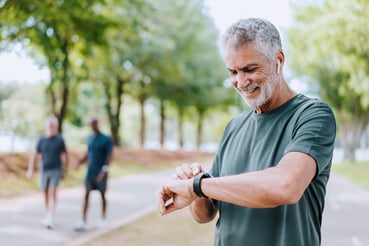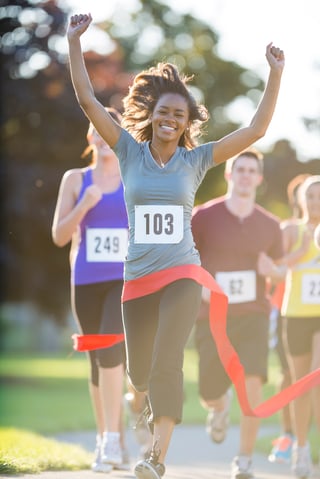You’re on your way to 100 miles! How you get there is up to you. Yes, you can take the route most traveled and walk or run your way to hit quota. But here is a little start-up advice for anyone interested in the other low impact options available to get your miles in through the challenge:
Cycling
With the ratio of 3 miles cycled to 1 mile counted toward your quota, you want to make sure your bike is set up correctly for your body. First, while standing on the ground, the seat should be even with the top of your hip bone. This should allow appropriate length from your hips to your pedals. An easy secondary check is to sit on the bike seat and make sure your leg is straight with your heel on the pedal (rather than your midfoot, like you would to ride). Most stationary bikes do not allow an adjustment for the handles and display. But if you’re putting in miles on a spin bike, you’ll certainly be able to make it more comfortable by repositioning the handlebars to your liking. Since you aren’t worried about wind resistance, it is okay to set your handlebars up high and be in a comfortable, upright position.
One last tip for mileage tracking: Most spin bikes do not accommodate for a “gear” or level increase; meaning you will accrue miles faster the faster you pedal!
Spin Bike Safety: Unlike trail bikes or stationary exercise bikes, spin bike pedals are fixed to the fly wheel and do not slowdown like a regular cycle. Use the stop function by pressing the resistance knob if your feet come out of the pedal cage or you need to stop quickly.
Rowing
 Every 1600 meters on the row machine is 1 mile towards your goal! If you have never used a row machine before, here are some quick tips to get you started on your journey:
Every 1600 meters on the row machine is 1 mile towards your goal! If you have never used a row machine before, here are some quick tips to get you started on your journey:
First, slide your foot into the footrests; they have a strap to lock your toes in place and a heel cup that will allow the bottom to follow your foot up as you bring the seat back to the starting position. When you slide forward all the way (the beginning of your stroke), your shin bones should be perpendicular to the floor. If your shin bones don’t line up, adjust the sliders on the footrests to allow the appropriate movement pattern.
Once you have gotten yourself in proper starting position and tightened your straps around your foot, grab the handle, engage your core and back muscles while you use your legs to push yourself backwards. Once your legs are straight, lean back (following the movement with your body), and then pull the handle to your body with your arms to finish. To return to your starting position, reverse the order, straighten your arms, bring your upper body forward, and bend your legs to slide back to the starting position.
Resistance? There is a resistance toggle on the fan of some row machines. Best practice for continuous effort, distance rowing, is to stick in the 4-5 range (usually halfway). If you’re looking to increase strength and put in miles at the same time, you can certainly crank it up – but I would start slowly and build your rowing pattern efficiency first!
Elliptical
The elliptical machine is mile for mile in the 500 challenge. If you are just starting out or haven’t worked out regularly for some time, an elliptical is a great place to start to build you endurance. The machine is very user friendly and accommodating to most body shapes and sizes.
Step onto the machine while holding one of the fixed handles (the tall handles move with the pedals). Once you begin pedaling, the display will come on. Adjust the resistance level and incline of your pedal stroke to find the most comfortable setup for you. The pedals are very large to allow an appropriate foot placement for most heights.
In general, you want to avoid locking your knees or bouncing while on the elliptical. You should be able to keep your feet comfortably on the pedals through the entire movement. Keep it smooth and start slowly with your back straight and head tall.
Whatever mode you choose, always remember that the NIFS staff is available to help set up your machine or show you how every machine in our facility works. If you have general questions or want to try something new, please direct those questions to our staff in person or via email at any time. Most of all, have fun and stay safe on the road to 500!


 When deciding what workout gear to buy, take a moment to consider key factors like weather conditions, material types, fit, comfort, and function. These features are worth reviewing before you hit “add to cart.”
When deciding what workout gear to buy, take a moment to consider key factors like weather conditions, material types, fit, comfort, and function. These features are worth reviewing before you hit “add to cart.” Footwear is one of the most essential pieces of equipment for anyone who participates in many forms of exercise, whether for recreational purposes or as a competitive athlete. While it may seem like a simple piece of equipment, running shoes are designed with advanced materials and proper biomechanical stability in mind, aimed at enhancing performance, reducing injury risk, and providing comfort. The right pair of shoes can significantly affect a person's exercise experience. Understanding the various factors that go into their design is necessary when deciding on the next pair of shoes.
Footwear is one of the most essential pieces of equipment for anyone who participates in many forms of exercise, whether for recreational purposes or as a competitive athlete. While it may seem like a simple piece of equipment, running shoes are designed with advanced materials and proper biomechanical stability in mind, aimed at enhancing performance, reducing injury risk, and providing comfort. The right pair of shoes can significantly affect a person's exercise experience. Understanding the various factors that go into their design is necessary when deciding on the next pair of shoes.
 Running can be a great form of exercise; it can also be frustrating if you’ve hit a plateau or feel like you are not very good at it. The key to enjoying running might not be running longer but running smarter. Variable speed and intensity training techniques, such as intervals, tempo runs, and Fartlek workouts, can help build endurance, increase efficiency, and make your runs more dynamic. Whether you’re training for a 5K or a marathon, these methods can take your stamina to the next level.
Running can be a great form of exercise; it can also be frustrating if you’ve hit a plateau or feel like you are not very good at it. The key to enjoying running might not be running longer but running smarter. Variable speed and intensity training techniques, such as intervals, tempo runs, and Fartlek workouts, can help build endurance, increase efficiency, and make your runs more dynamic. Whether you’re training for a 5K or a marathon, these methods can take your stamina to the next level. Improving your running time and efficiency can seem overwhelming. Whether you are a beginner or well-seasoned runner there is always room for performance improvement.
Improving your running time and efficiency can seem overwhelming. Whether you are a beginner or well-seasoned runner there is always room for performance improvement.
.jpg?width=447&name=GettyImages-1173137476%20(1).jpg) Oh, my aching feet! More importantly, why do my feet hurt? Let me explain further. At times in the past, the top of my foot has felt like it was being crushed by the laces of my sneakers. I logically thought that all I needed to do was loosen the laces of my sneakers and it would solve the problem. It did not help. Really, all it did was create more problems because then my sneakers felt like they were going to fall off, and then the loose-fitting sneakers began to rub on and irritate my heels. On top of that, when I did loosen the laces, the shoes would then come untied too easily.
Oh, my aching feet! More importantly, why do my feet hurt? Let me explain further. At times in the past, the top of my foot has felt like it was being crushed by the laces of my sneakers. I logically thought that all I needed to do was loosen the laces of my sneakers and it would solve the problem. It did not help. Really, all it did was create more problems because then my sneakers felt like they were going to fall off, and then the loose-fitting sneakers began to rub on and irritate my heels. On top of that, when I did loosen the laces, the shoes would then come untied too easily.
.jpg?width=464&name=Traveling-Airport%20GettyImages-495963242%20(1).jpg)

 I was looking for fitness challenge. I had already been running 5k races and had either won or placed in every race (6) within my age group, so I felt like I was ready for more. My mother suggested I race a half-marathon. Truly, running 13.1 miles sounded awful and I had no desire to run that far for pure enjoyment. Suddenly, I found myself logging longer runs on the weekends just to test my endurance. When early registration came for the
I was looking for fitness challenge. I had already been running 5k races and had either won or placed in every race (6) within my age group, so I felt like I was ready for more. My mother suggested I race a half-marathon. Truly, running 13.1 miles sounded awful and I had no desire to run that far for pure enjoyment. Suddenly, I found myself logging longer runs on the weekends just to test my endurance. When early registration came for the  It’s true, signing up for a 5K or a triathlon can be fairly intimidating for a first-timer. The fear of going too slow, finishing last or even not finishing at all can hold someone back from completing their first race. The fact is, very few competitors are attempting to come in first place. Most are just trying to finish! The benefits of racing are countless and most have absolutely nothing to do with how fast you go. Here are my top 5 reasons why you should complete a race:
It’s true, signing up for a 5K or a triathlon can be fairly intimidating for a first-timer. The fear of going too slow, finishing last or even not finishing at all can hold someone back from completing their first race. The fact is, very few competitors are attempting to come in first place. Most are just trying to finish! The benefits of racing are countless and most have absolutely nothing to do with how fast you go. Here are my top 5 reasons why you should complete a race: Six months ago, a friend dared me to give up cardio for three months and focus on strength training. My initial response was, “No way! I’m a runner, I’ve always been a runner. There is no better exercise than running!” My friend was relentless and eventually I agreed to take a brief hiatus, although I was convinced that I would turn into a mushy ball of goo if I didn’t get in my daily run.
Six months ago, a friend dared me to give up cardio for three months and focus on strength training. My initial response was, “No way! I’m a runner, I’ve always been a runner. There is no better exercise than running!” My friend was relentless and eventually I agreed to take a brief hiatus, although I was convinced that I would turn into a mushy ball of goo if I didn’t get in my daily run. 